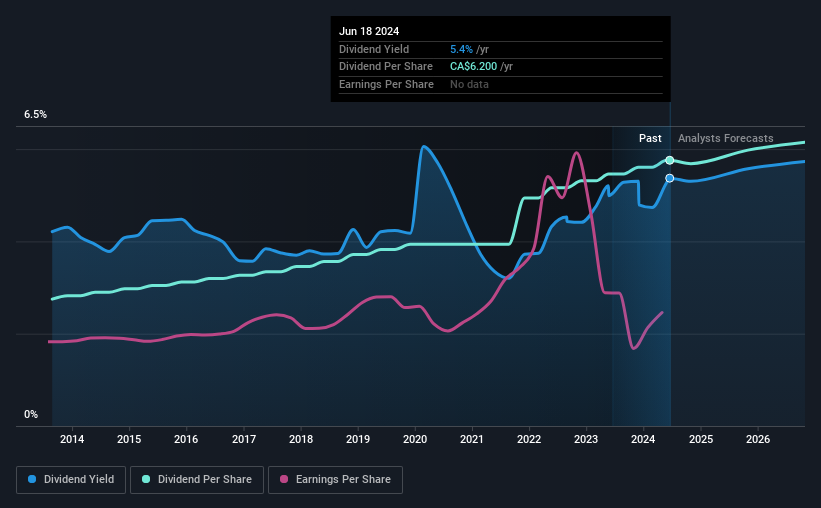Bank of Montreal (TSE:BMO) Is Paying Out A Larger Dividend Than Last Year
Bank of Montreal (TSE:BMO) will increase its dividend from last year's comparable payment on the 27th of August to CA$1.55. The payment will take the dividend yield to 5.4%, which is in line with the average for the industry.
View our latest analysis for Bank of Montreal
Bank of Montreal's Payment Expected To Have Solid Earnings Coverage
While it is always good to see a solid dividend yield, we should also consider whether the payment is feasible.
Bank of Montreal has established itself as a dividend paying company with over 10 years history of distributing earnings to shareholders. Past distributions do not necessarily guarantee future ones, but Bank of Montreal's payout ratio of 72% is a good sign as this means that earnings decently cover dividends.
Looking forward, EPS is forecast to rise by 54.0% over the next 3 years. Analysts estimate the future payout ratio will be 53% over the same time period, which is in the range that makes us comfortable with the sustainability of the dividend.
Bank of Montreal Has A Solid Track Record
The company has an extended history of paying stable dividends. Since 2014, the dividend has gone from CA$2.96 total annually to CA$6.20. This works out to be a compound annual growth rate (CAGR) of approximately 7.7% a year over that time. The growth of the dividend has been pretty reliable, so we think this can offer investors some nice additional income in their portfolio.
Dividend Growth May Be Hard To Achieve
Investors could be attracted to the stock based on the quality of its payment history. However, things aren't all that rosy. Bank of Montreal has seen earnings per share falling at 2.7% per year over the last five years. If earnings continue declining, the company may have to make the difficult choice of reducing the dividend or even stopping it completely - the opposite of dividend growth. However, the next year is actually looking up, with earnings set to rise. We would just wait until it becomes a pattern before getting too excited.
Our Thoughts On Bank of Montreal's Dividend
In summary, it's great to see that the company can raise the dividend and keep it in a sustainable range. With shrinking earnings, the company may see some issues maintaining the dividend even though they look pretty sustainable for now. This looks like it could be a good dividend stock going forward, but we would note that the payout ratio has been at higher levels in the past so it could happen again.
It's important to note that companies having a consistent dividend policy will generate greater investor confidence than those having an erratic one. Still, investors need to consider a host of other factors, apart from dividend payments, when analysing a company. Taking the debate a bit further, we've identified 1 warning sign for Bank of Montreal that investors need to be conscious of moving forward. Looking for more high-yielding dividend ideas? Try our collection of strong dividend payers.
Have feedback on this article? Concerned about the content? Get in touch with us directly. Alternatively, email editorial-team (at) simplywallst.com.
This article by Simply Wall St is general in nature. We provide commentary based on historical data and analyst forecasts only using an unbiased methodology and our articles are not intended to be financial advice. It does not constitute a recommendation to buy or sell any stock, and does not take account of your objectives, or your financial situation. We aim to bring you long-term focused analysis driven by fundamental data. Note that our analysis may not factor in the latest price-sensitive company announcements or qualitative material. Simply Wall St has no position in any stocks mentioned.
Have feedback on this article? Concerned about the content? Get in touch with us directly. Alternatively, email editorial-team@simplywallst.com

 Yahoo Finance
Yahoo Finance 
